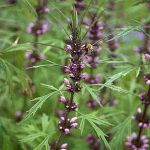| Common Name: |
Chinese Motherwort |
| Botanical Name: |
Leonurus sibiricus |
| Genus: |
Leonurus |
| Family: |
Lamiaceae |
| Native Location: |
Siberia, China, Korea, and Taiwan |
| Cultivation: |
Well-drained, moist soil in sun or partial shade. |
| Propagation: |
By seed sown in spring; by division in spring or autumn (L. cardiaca). |
| Harvest: |
Plants are cut when flowering, but before the seeds are set, and dried for infusions, liquid extracts, and tinctures (L. cardiaca), or in decoctions, pills, powders, and poultices (L. sibiricus). Seeds (L. sibiricus) are collected when ripe in autumn by drying the whole plant, and threshing and sifting it to remove seeds. |
| Height: |
1m (3ft) |
| Width: |
60cm (24in) |
| Hardiness: |
Z4-8 |
| Parts Used: |
Whole plant (yi mu cao), seeds (chong wei zu) |
| Properties: |
A bitter, diuretic herb that stimulates the circulation and uterus, lowers blood pressure, regulates menstruation, and clears toxins. It is also effective against bacterial and fungal infections. Seeds are slightly sweet and have similar actions but ar less effective as a diuretic and detoxicant. |
| Medicinal Uses: |
Internally for eye problems related to the liver meridian (seeds); painful and excessive menstruation, postpartum bleeding (whole plants, seeds); edema, kidney complaints, kidney stones, eczema, and abscesses (whole plant). Not given to pregnant women. |
| Culinary Uses: |
Young foliage is eaten as a vegetable. Roots are cooked with pork (China). |
| Bibliography: |
The Encylopedia of Herbs by Deni Bown Copyright © 1995, 2001 Dorling Kindersley Limited pp 258-9 |

